1993 CHEVROLET ASTRO PASSENGER air condition
[x] Cancel search: air conditionPage 213 of 345
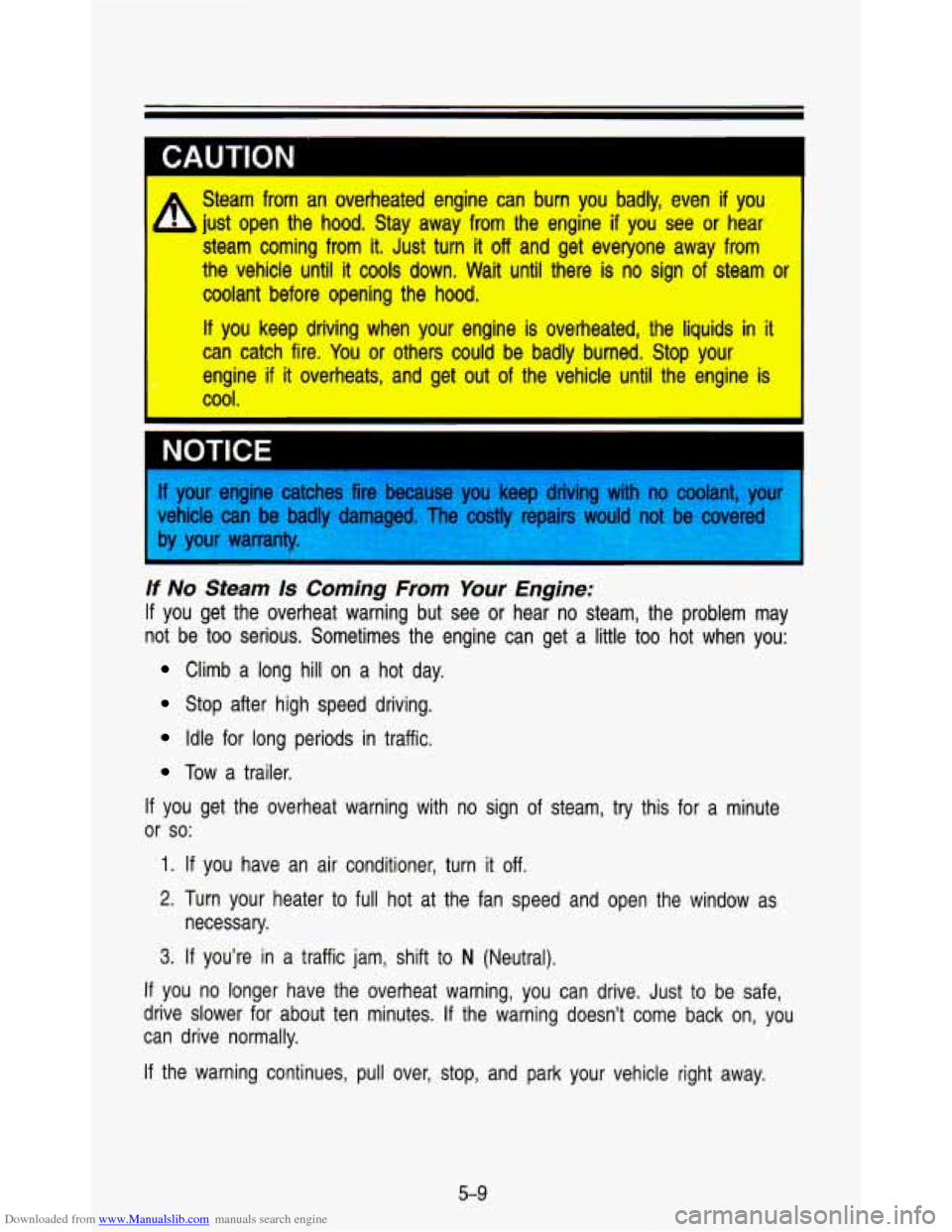
Downloaded from www.Manualslib.com manuals search engine CALITION
I
Steam from an overheated engine can burn you badly, even if you
just open the hood. Stay away from the engine
if you see or hear
steam coming from it. Just turn it
off and get everyone away from
the vehicle until it cools down. Wait until there is no sign of steam
or
coolant before opening the hood.
If you keep driving when your engine is overheated, the liquids in it
can catch fire. You or others could be badly burned. Stop your
engine
if it overheats, and get out of the vehicle until the engine is
cool
m
NOTICE ~~ ~
I your engine catches fire because you keep driving with no coolant, yolrl
lehicle can be badly damaged.
Thrr costly repairs would not be covered
y your warranty.
If No Steam /s Coming From Your Engine:
If you get the overheat warning but see or hear no steam, the problem may
not be
too serious. Sometimes the engine can get a little too hot when you:
Climb a long hill on a hot day.
Stop after high speed driving.
Idle for long periods in traffic.
Tow a trailer.
If you get the overheat warning with no sign of steam, try t\
his for a minute
or
so:
1. If you have an air conditioner, turn it off.
2. Turn your heater to full hot at the fan speed and open the window as
necessary.
3. If you’re in a traffic jam, shift to N (Neutral).
If you no longer have the overheat warning, you can drive. Just to be safe,
drive slower for about ten minutes.
If the warning doesn’t come back on, you
can drive normally.
If the warning continues, pull over, stop, and park your vehicle \
right away.
5-9
Page 220 of 345
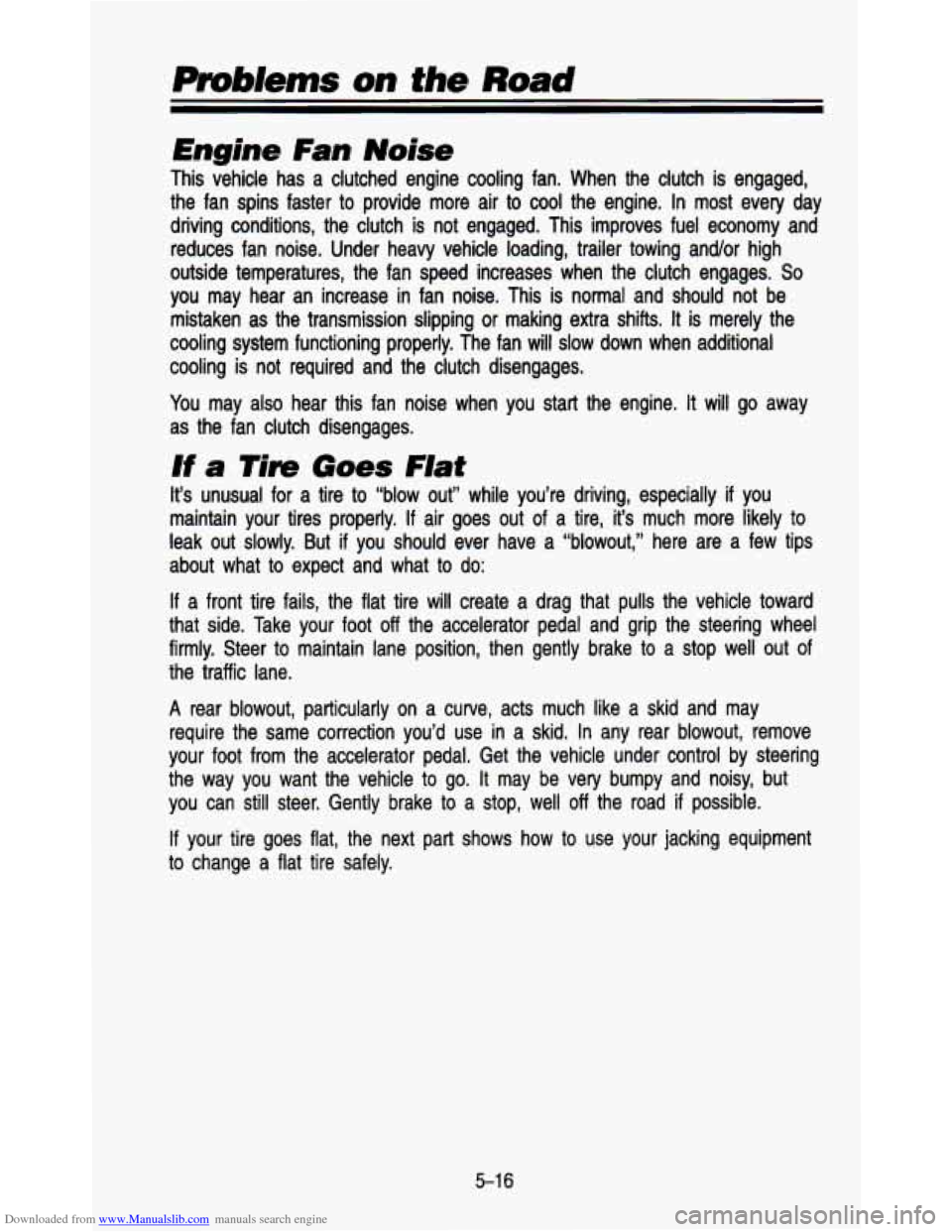
Downloaded from www.Manualslib.com manuals search engine Pmblems on the Road
Engine Fan Noise
This vehicle has a clutched engine cooling fan. When the clutc\
h is engaged,
the fan spins faster
to provide more air to cool the engine. In most every day
driving conditions, the clutch is not engaged. This improves fu\
el economy and
reduces fan noise. Under heavy vehicle loading, trailer towing \
andlor high
outside temperatures, the fan speed increases when the clutch e\
ngages.
So
you may hear an increase in fan noise. This is normal and should not be
mistaken as the transmission slipping
or making extra shifts. It is merely the
cooling system functioning properly. The fan will slow down whe\
n additional
cooling is not required and the clutch disengages.
You may also hear this fan noise when you start the engine.
It will go away
as the fan clutch disengages.
If a Tim Goes Flat
It’s unusual for a tire to “blow out” while you’re driving, especially if you
maintain your tires properly.
If air goes out of a tire, it’s much more likely to
leak out slowly. But
if you should ever have a “blowout,” here are a few tips
about what to expect and what
to do:
If a front tire fails, the flat tire will create a drag that pulls the vehicle toward
that side. Take your foot
off the accelerator pedal and grip the steering wheel
firmly. Steer
to maintain lane position, then gently brake to a stop well out of
the traffic lane.
A rear blowout, particularly on a curve, acts much like a skid \
and may
require the same correction you’d use in a skid. In any rear blowout, remove
your foot from the accelerator pedal. Get the vehicle under co\
ntrol by steering
the way you want the vehicle
to go. It may be very bumpy and noisy, but
you can still steer. Gently brake
to a stop, well off the road if possible.
If your tire goes flat, the next part shows how to use your jacking equipment
to change a flat tire safely.
5-1 6
Page 270 of 345
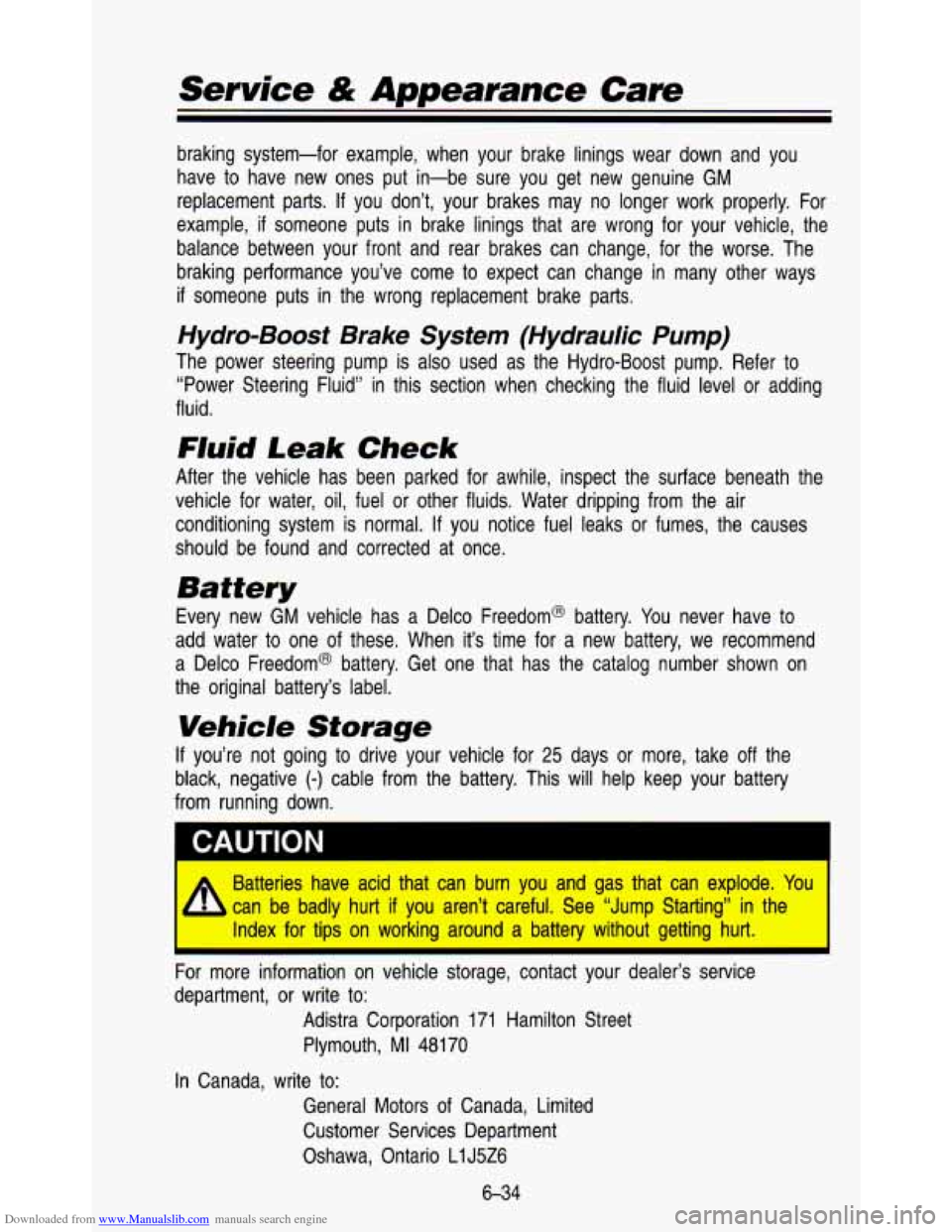
Downloaded from www.Manualslib.com manuals search engine Service & Appearance Care
braking system-for example, when your brake linings wear down and you
have
to have new ones put in-be sure you get new genuine GM
replacement parts.
If you don’t, your brakes may no longer work properly. For
example,
if someone puts in brake linings that are wrong for your vehicle, the
balance between your front and rear brakes can change, for the\
worse. The
braking performance you’ve come to expect can change in many\
other ways
if someone puts in the wrong replacement brake parts.
Hydro-Boost Brake System (Hydraulic Pump)
The power steering pump is also used as the Hydro-Boost pump. \
Refer to
“Power Steering Fluid” in this section when. checking the fluid level or adding
fluid.
Fluid Leak Check
After the vehicle has been parked for awhile, inspect the surf\
ace beneath the
vehicle for water, oil, fuel or other fluids. Water dripping f\
rom the air
conditioning system is normal. If you notice fuel leaks or fumes, the causes
should be found and corrected at once.
Battery
Every new GM vehicle has
add water
to one of these,
a Delco Freedom@ battery.
the original battery’s label. a Delco Freedom@ battery. You never have
to
When it’s time for a new battery, we recommend
Get one that has the catalog number shown on
Vehicle Storage
If you’re not going to drive your vehicle for 25 days or more, take off the
black, negative
(-) cable from the battery. This will help keep your battery
from running down.
I CAUTION
For more informarlon on vehicle storage, contact your dealer’\
s service
department, or write to:
Adistra Corporation 171 Hamilton Street Plymouth,
MI 48170
General Motors
of Canada, Limited
Customer Services Department
Oshawa, Ontario L1 J5Z6
In
Canada, write
to:
6-34
Page 275 of 345
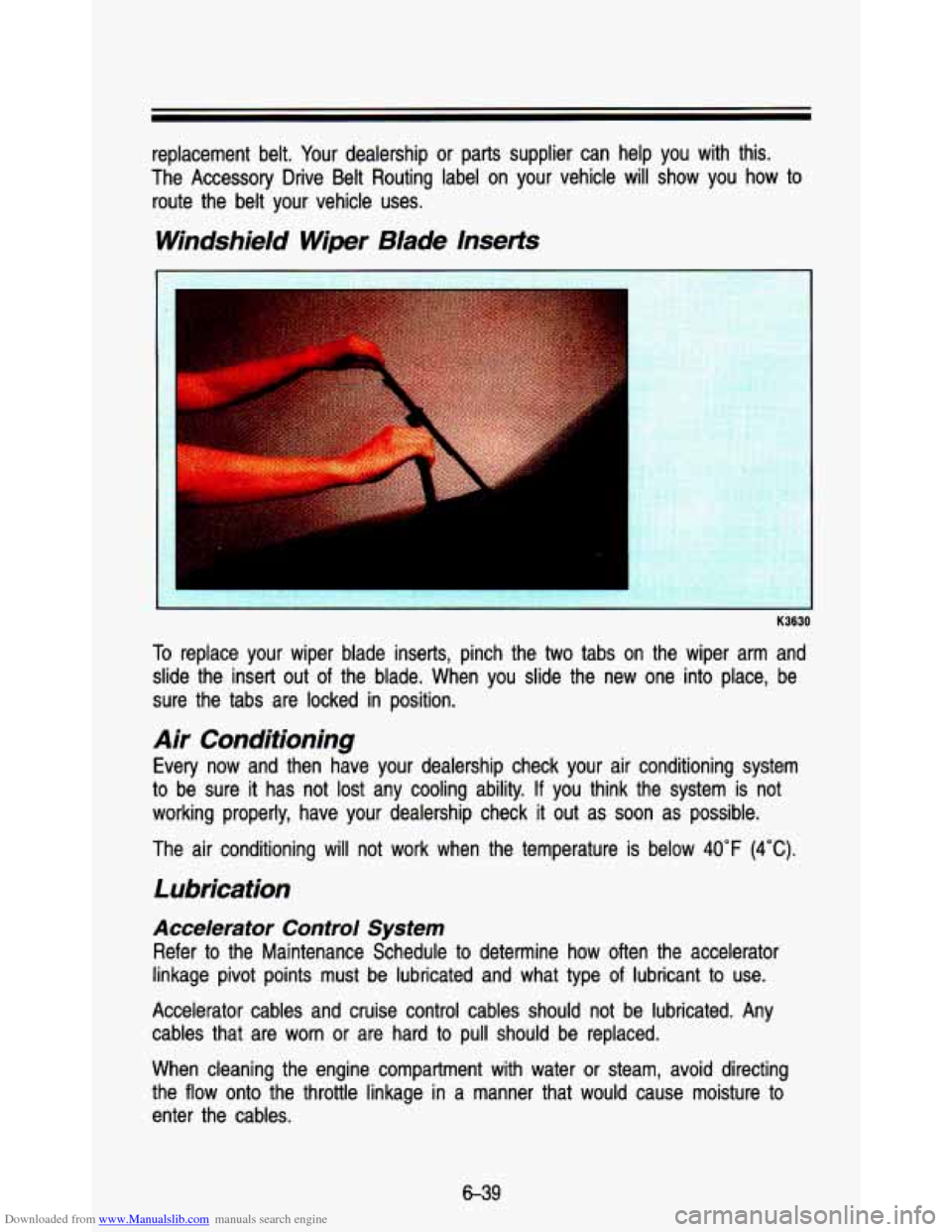
Downloaded from www.Manualslib.com manuals search engine replacement belt. Your dealership or parts supplier can help you with this.
The Accessory Drive Belt Routing label on your vehicle will sh\
ow you how to route the belt your vehicle uses.
Windshield Wiper Blade lnsetts
I
K3630
To replace your wiper blade inserts, pinch the two tabs on the wiper arm and
slide the insert out of the blade. When you slide the new one into place, be
sure the tabs are locked in position.
Air Conditioning
Every now and then have your dealership check your air conditi\
oning system
to be sure it has not lost any cooling ability.
If you think the system is not
working properly, have your dealership check it out as soon as\
possible.
The air conditioning will not work when the temperature is bel\
ow
40°F (4°C).
Lubrication
Accelerator Control System
Refer to the Maintenance Schedule to determine how often the accelerator
linkage pivot points must be lubricated and what type
of lubricant to use.
Accelerator cables and cruise control cables should not be lubr\
icated. Any
cables that are worn
or are hard to pull should be replaced.
When cleaning the engine compartment with water or steam, avoid\
directing
the flow onto the throttle linkage in a manner that would cause moisture to
enter the cables.
6-39
Page 294 of 345
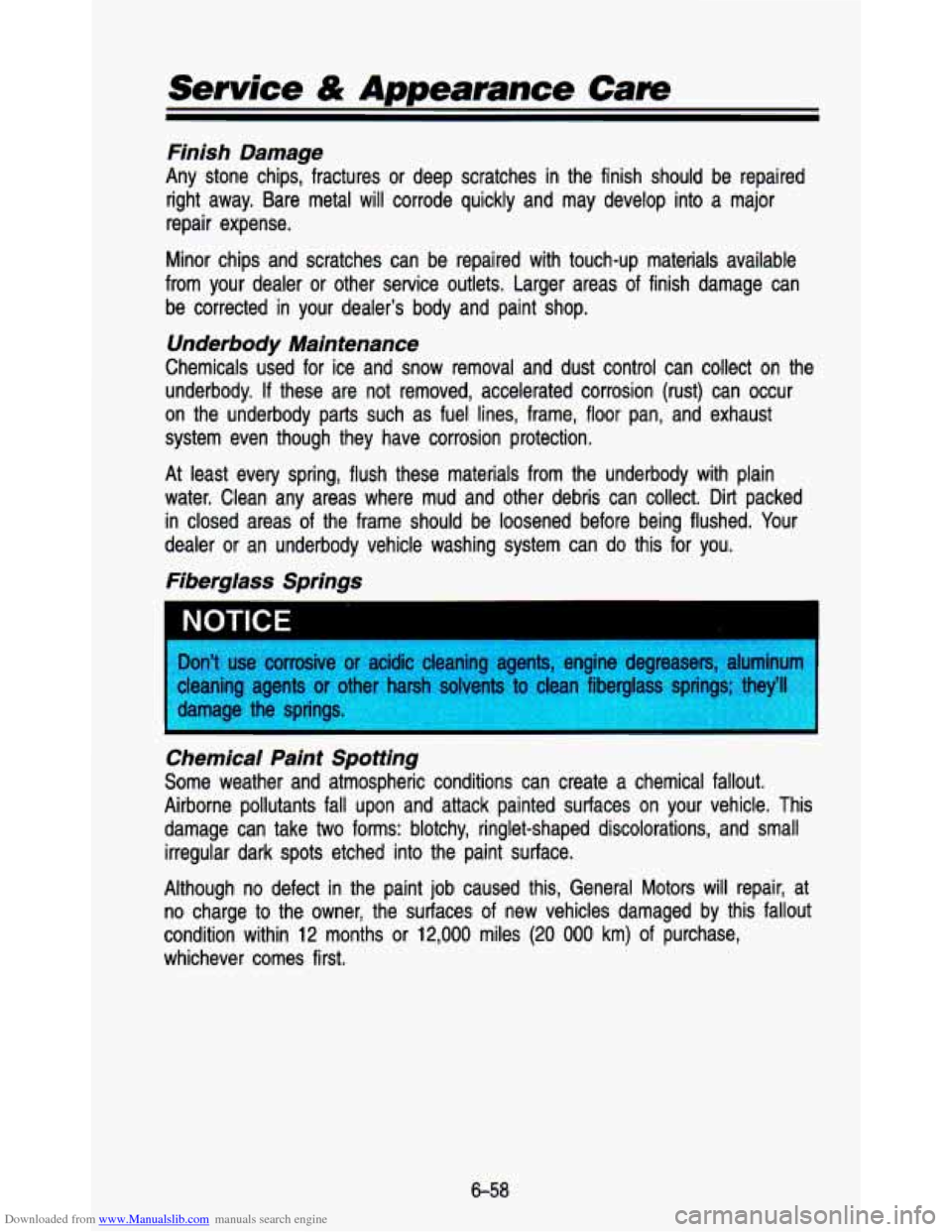
Downloaded from www.Manualslib.com manuals search engine Service & Appearance Cam
Finish Damage
Any stone chips, fractures or deep scratches in the finish should be repaired
right away. Bare metal will corrode quickly and may develop in\
to a major
repair expense.
Minor chips and scratches can be repaired with touch-up materia\
ls available
from your dealer
or other service outlets. Larger areas of finish damage can
be corrected in your dealer's body and paint shop.
Underbody Maintenance
Chemicals used for ice and snow removal and dust control can \
collect on the
underbody.
If these are not removed, accelerated corrosion (rust) can occur \
on the underbody parts such as fuel lines, frame, floor pan, \
and exhaust
system even though they have corrosion protection.
At least every spring, flush these materials from the underbody\
with plain
water. Clean any areas where mud and other debris can collect.\
Dirt packed
in closed areas of the frame should be loosened before being flus\
hed. Your
dealer
or an underbody vehicle washing system can do this for you.
Fiberglass Springs
I NOTICE
Don't use corrosive or acidic cleaning agents, engine degreasers, aluminum
cleaning agents
or 0'' r hars' solven' . ' an fiberglass springs; t' r'll
damage the springs.
Chemical Paint Spotting
Some weather and atmospheric conditions can create a chemical f\
allout.
Airborne pollutants fall upon and attack painted surfaces on yo\
ur vehicle. This
damage can take
two forms: blotchy, ringlet-shaped discolorations, and small
irregular dark spots etched into the paint surface.
Although no defect in the paint job caused this, General Motor\
s
will repair, at
no charge
to the owner, the surfaces of new vehicles damaged by this fallou\
t
condition within
12 months or 12,000 miles (20 000 km) of purchase,
whichever comes first.
6-58
Page 301 of 345

Downloaded from www.Manualslib.com manuals search engine Air Conditioning Refrigerants
Not all air conditioning refrigerants are the same. If the air conditioning
system in your vehicle needs refrigerant, be sure the proper refrigerant
is
used. If you’re not sure, ask your GM dealer.
Air Conditioning Refrigerant Capacity
TYPE SYSTEM QUANTITY
R-12 C-60 3.00
Ibs. (1.4 kg)
R-12 C-69 3.75 Ibs. (1.7 kg)
Crankcase
QUANTITY
ENGINE Without Filter
I With Filter
VIN CODE
4.3L
4.5 Quarts
(4.3 Liters) 4 Quarts (3.8 Liters) W 4.3L
4.5 Quarts (4.3 Liters) 4 Quarts (3.8 Liters) Z
All quantities are approximate.
After refill, the level
MUST be checked.
TO1 8E
Fuel Tank
TYPE QUANTITY
Standard 27 Gallons (102 Liters)
I
Quantity is approximate.
TO1 87 I
6-65
Page 304 of 345

Downloaded from www.Manualslib.com manuals search engine Service & Appearance Care
Fuses and Circuit Breakers Usage
Name
Inst. Lps.
Pwr. Acc.
Horn-Dm.
Gages
Aux. Htr. NC
Stop-Haz.
Tail Lps.
Turn
BIU
Htr. NC
Radio
ECM B
ECM
I
Pwr. Wdo.
Wiper
Brake
Fog Lamps***
DRL**
Pow. Mirrors*
Trailer*
Circuits Protected
Instrument Panel Lamps, Radio Dial
Lamps, Heater Lamps
Power Door Locks, Power Seat
Horn Relay, Digital Clock, Cigarette
Lighter, Dome Lights, Radio Memory,
Glove Box Lamp
Instrument Cluster Gages, Brake
Switch, Audio Alarm, Headlight Switch
Illumination, Ash Tray Illumination,
Cruise Control
Auxiliary Heater-Rear NC
(if equipped)
Stop Lamps, Hazard Flash, Digital
Instrument Cluster
Headlamp Switch, Tail and Parking
Lamps
Direction Signal Flash, Back Up
Lamps
Front Heater
& Air Conditioning
Radio
Engine Control Module
Engine Control Module
Power Windows
Windshield Wiper
Anti-Lock Brake System,
Speedometer
Fog Lamps
Canadian Daytime Running Lights
Power Mirror
Trailer Wirina Harness
Fuse
10 Amp
30 Amp
20 Amp
25 Amp
20 Amp
20 Amp
20 Amp
20 Amp
10 Amp
10 Amp
10 Amp
25 Amp
15 Amp
15 Amp
10 Amp
3 Amp
30 Amr,
Circuit
Breaker
30 Amp
30 Amp
*In-line fuse.
**Canada only.
“*In-line fuse (certain models).
TO007
6-68
Page 308 of 345
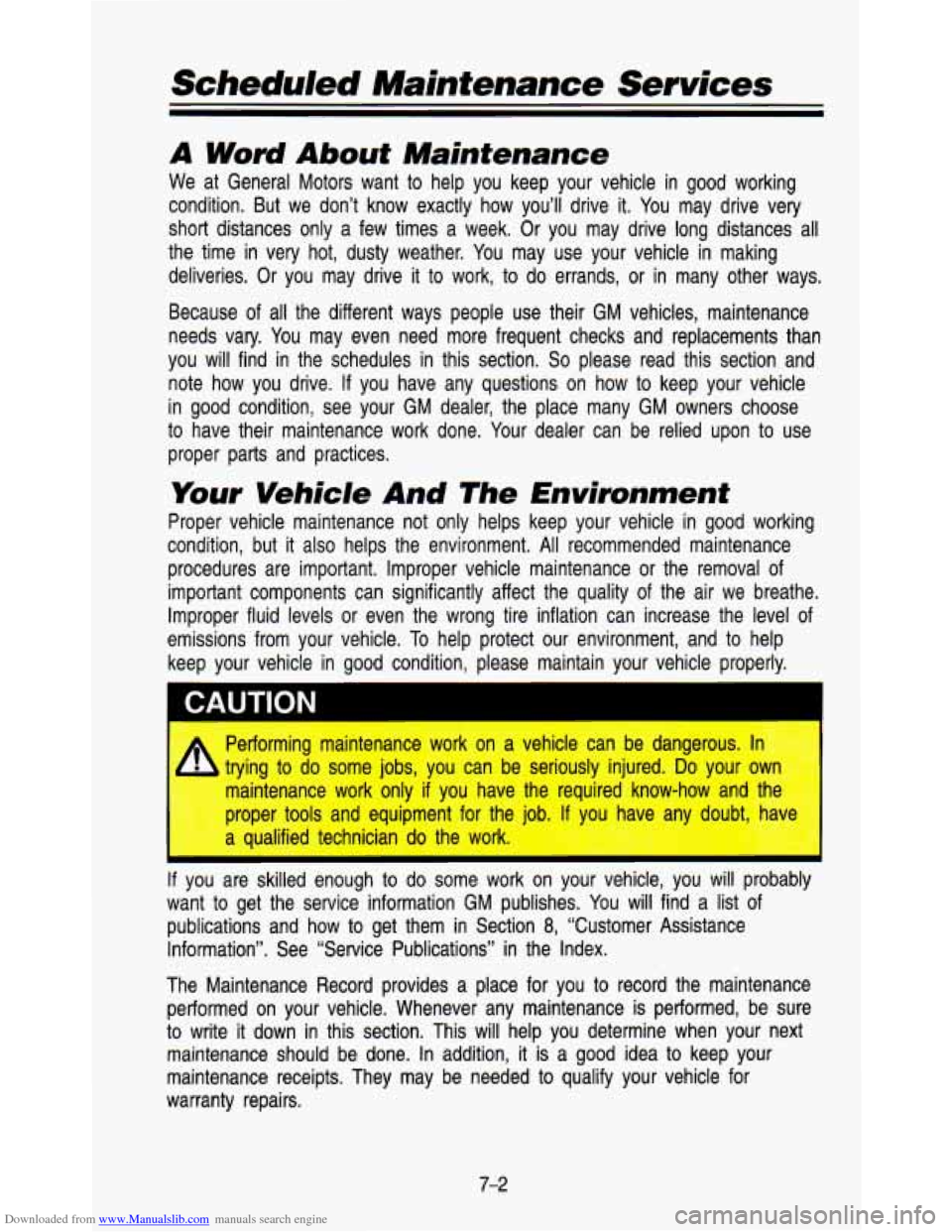
Downloaded from www.Manualslib.com manuals search engine Scheduled Maintenance Services
A Word About Maintenance
We at General Motors want to help you keep your vehicle in good working
condition. But we don’t know exactly how you’ll drive it. You may drive very
short distances only a few times a week. Or you may drive lo\
ng distances all
the time
in very hot, dusty weather. You may use your vehicle in making
deliveries. Or you may drive
it to work, to do errands, or in many other ways.
Because
of all the different ways people use their GM vehicles, maintenance
needs vary. You may even need more frequent checks and replacements than
you will find in the schedules in this section.
So please read this section and
note how you drive. If you have any questions on how
to keep your vehicle
in good condition, see your GM dealer, the place many
GM owners choose
to have their maintenance work done. Your dealer can be relied upon to use
proper parts and practices.
Your Vehicle And The Environment
Proper vehicle maintenance not only helps keep your vehicle in good working
condition, but it also helps the environment.
All recommended maintenance
procedures are important. Improper vehicle maintenance or the re\
moval of
important components can significantly affect the quality of the air we breathe.
Improper fluid levels or even the wrong tire inflation can inc\
rease the level of
emissions from your vehicle. To help protect our environment, and to help
keep your vehicle in good condition, please maintain your vehic\
le properly.
CAUTION
. Performing maintenance work on a vehicle can be dangerous. ...
trying to do some jobs, you can be seriously injured. Do your own
maintenance work only
if you have the reauired know-how and the
proper
tools and equipment for the iob. IOU have ar doubt. have
a qualified technician do the
WOrK. I
If you are skilled enough to do some work on your vehicle, you will probably
want
to get the service information GM publishes. You will find a list of
publications and how to get them in Section
8, “Customer Assistance
Information”. See “Service Publications’’ in the Index.
The Maintenance Record provides a place for you to record the maintenance
performed on your vehicle. Whenever any maintenance is performed, be sure
to write
it down in this section. This will help you determine when your next
maintenance should be done. In addition,
it is a good idea to keep your
maintenance receipts. They may be needed to qualify your vehicle for
warranty repairs.
7-2